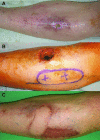Changes of anabolic processes at the cellular and molecular level in chronic wounds under topical negative pressure can be revealed by transcriptome analysis
- PMID: 20716124
- PMCID: PMC3823200
- DOI: 10.1111/j.1582-4934.2010.01147.x
Changes of anabolic processes at the cellular and molecular level in chronic wounds under topical negative pressure can be revealed by transcriptome analysis
Abstract
Chronic wounds--as defined by the World Union of Wound Healing Societies (WUWHS)--are a considerable worldwide health care expense and impair quality of life. In order for chronic wounds to heal, these wounds must be transformed to a more acute state to begin the healing process. Topical negative pressure (TNP) with reticulated open cell foam (ROCF) is known to promote healing in certain types of chronic wounds. However, little is known about changes at the cellular or molecular level in wounds under various treatments, especially under the physical forces induced to tissue by TNP. In the current study, chronic wound samples were obtained during routine wound debridements prior to treatment and 7-12 days after initiating TNP with a continuous setting at -125 mmHg. Whole genome transcriptome microarray analyses were performed on samples to better understand how TNP with ROCF affects these types of wounds. It was found that more genes were expressed following TNP with ROCF as compared to before therapy and to normal, non-wounded tissue. In this study, we show that TNP with ROCF transforms the chronic wound from its inflammation (non-healing) state into more of a progressive, healing phenotype from a molecular point of view with expression of genes that are commonly associated with these terms.
© 2011 The Authors Journal of Cellular and Molecular Medicine © 2011 Foundation for Cellular and Molecular Medicine/Blackwell Publishing Ltd.
Figures





Similar articles
-
Vessel transformation in chronic wounds under topical negative pressure therapy: an immunohistochemical analysis.Int Wound J. 2015 Oct;12(5):501-9. doi: 10.1111/iwj.12143. Epub 2013 Sep 13. Int Wound J. 2015. PMID: 24028468 Free PMC article.
-
Use of Negative Pressure Wound Therapy With Instillation and a Novel Reticulated Open-cell Foam Dressing With Through Holes at a Level 2 Trauma Center.Wounds. 2019 Feb;31(2):55-58. Epub 2018 Nov 22. Wounds. 2019. PMID: 30485170
-
Early-stage Management of Complex Lower Extremity Wounds Using Negative Pressure Wound Therapy With Instillation and a Reticulated Open Cell Foam With Through Holes.Wounds. 2020 Jun;32(6):159-163. Epub 2020 Mar 31. Wounds. 2020. PMID: 32335516
-
A review of topical negative pressure therapy in wound healing: sufficient evidence?Am J Surg. 2011 Apr;201(4):544-56. doi: 10.1016/j.amjsurg.2010.04.029. Am J Surg. 2011. PMID: 21421104 Review.
-
Negative-pressure wound therapy: a snapshot of the evidence.Int Wound J. 2006 Dec;3(4):261-71. doi: 10.1111/j.1742-481X.2006.00266.x. Int Wound J. 2006. PMID: 17199762 Free PMC article. Review.
Cited by
-
Negative pressure wound therapy promotes wound healing by down-regulating miR-155 expression in granulation tissue of diabetic foot ulcers.Sci Rep. 2025 Feb 25;15(1):6733. doi: 10.1038/s41598-025-90643-7. Sci Rep. 2025. PMID: 40000694 Free PMC article. Clinical Trial.
-
Vessel transformation in chronic wounds under topical negative pressure therapy: an immunohistochemical analysis.Int Wound J. 2015 Oct;12(5):501-9. doi: 10.1111/iwj.12143. Epub 2013 Sep 13. Int Wound J. 2015. PMID: 24028468 Free PMC article.
-
A hundred patients with vertical rectus abdominis myocutaneous (VRAM) flap for pelvic reconstruction after total pelvic exenteration.Int J Colorectal Dis. 2014 Jul;29(7):813-23. doi: 10.1007/s00384-014-1868-0. Epub 2014 Apr 22. Int J Colorectal Dis. 2014. PMID: 24752738
-
PHDs inhibitor DMOG promotes the vascularization process in the AV loop by HIF-1a up-regulation and the preliminary discussion on its kinetics in rat.BMC Biotechnol. 2014 Dec 28;14:112. doi: 10.1186/s12896-014-0112-x. BMC Biotechnol. 2014. PMID: 25543909 Free PMC article.
-
[Pathogenesis, classification and diagnosis of necrotizing soft tissue infections].Chirurg. 2012 Nov;83(11):943-52. doi: 10.1007/s00104-012-2281-2. Chirurg. 2012. PMID: 23011149 Review. German.
References
-
- Argenta LC, Morykwas MJ. Vacuum-assisted closure: a new method for wound control and treatment: clinical experience. Ann Plast Surg. 1997;38:563–76. - PubMed
-
- Joseph E, Hamori CA, Bergman S, et al. A prospective, randomized trial of vacuum-assisted closure versus standard therapy of chronic nonhealing wounds. Wounds. 2000;12:60–7.
-
- Short B, Claxton M, Armstrong DG. How to use VAC therapy on chronic wounds. Podiatry Today. 2002;15:48–54.
-
- Sibbald RG, Mahoney J. A consensus report on the use of vacuum-assisted closure in chronic, difficult-to-heal-wounds. Ostomy Wound Manage. 2003;49:52–66. - PubMed
-
- Venturi ML, Attinger CE, Mesbahi AN, et al. Mechanisms and clinical applications of the vacuum-assisted closure (VAC) device: a review. Am J Clin Dermatol. 2005;6:185–94. - PubMed
Publication types
MeSH terms
LinkOut - more resources
Full Text Sources
Medical

